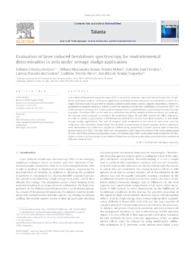Evaluation of laser induced breakdown spectroscopy for multielemental determination in soils under sewage sludge application.
Evaluation of laser induced breakdown spectroscopy for multielemental determination in soils under sewage sludge application.
Autoria: FERREIRA, E. C.; MILORI, D. M. B. P.; FERREIRA, E. J.; SANTOS, L. M. dos; MARTIN NETO, L.; NOGUEIRA, A. R. de A.
Resumo: Laser induced breakdown spectroscopy (LIBS) is an atomic emission spectroscopy technique for simple, direct and clean analysis, with great application potential in environmental sustainability studies. In a single LIBS spectrum it is possible to obtain qualitative information on the sample composition. However, quantitative analysis requires a reliable model for analytical calibration. Multilayer perceptron (MLP), an artificial neural network, is a multivariate technique that is capable of learning to recognize features from examples. Therefore MLP can be used as a calibration model for analytical determinations. Accordingly, the present study proposes to evaluate the traditional linear fit and MLP models for LIBS calibration, in order to attain a quantitative multielemental method for contaminant determination in soil under sewage sludge application. Two sets of samples, both composed of two kinds of soils were used for calibration and validation, respectively. The analyte concentrations in these samples, used as reference, were determined by a reference analytical method using inductively coupled plasma optical emission spectrometry (ICP OES). The LIBS?MLP was compared to a LIBS?linear fit method. The values determined by LIBS?MLP showed lower prediction errors, correlation above 98% with values determined by ICP OES, higher accuracy and precision, lower limits of detection and great application potential in the analysis of different kinds of soils.
Ano de publicação: 2011
Tipo de publicação: Artigo de periódico
Unidade: Embrapa Pecuária Sudeste
Observações
1 - Por padrão são exibidas publicações dos últimos 20 anos. Para encontrar publicações mais antigas, configure o filtro ano de publicação, colocando o ano a partir do qual você deseja encontrar publicações. O filtro está na coluna da esquerda na busca acima.
2 - Para ler algumas publicações da Embrapa (apenas as que estão em formato ePub), é necessário ter, no celular ou computador, um desses softwares gratuitos. Sistemas Android: Google Play Livros; IOS: iBooks; Windows e Linux: software Calibre.
Acesse outras publicações
Acesse a Base de Dados da Pesquisa Agropecuária (BDPA) para consultar o acervo completo das bibliotecas da Embrapa.

